Royal Domain of Drottningholm: Drottningholm Palace stands on Lovön Island in Lake Mälaren, situated on the western outskirts of Stockholm. Drottningholm is the home of the Royal Family of Sweden. Drottningholm Palace was destroyed by fire in 1661. A new palace was designed and the works started in 1662. Drottningholm Palace was rebuilt as we know it today. Drottningholm Palace was inspired by Versailles. Drottningholms Slottsteater was built in 1766 in the park of Drottningholm Palace. There are only five theaters of this kind in the world: one in Russia, one in Litomyšl Castle and one in Český Krumlov and two in Sweden. The Chinese Pavilion Kina Slott in Drottningholm Palace Park is an important example of the 18th century Chinoiserie, a style inspired by the art and design from China and other Asian countries. The Kina Slott was built in 1769. Most of the sculptures in Drottningholm Park are created by the Dutch artist Adriaen de Vries, one of the most famous sculptor of his generation. Adriaen de Vries, known as the Dutch Michelangelo, worked for several aristocratic families in Europe and was the court sculptor of Emperor Rudolph II in Prague. Drottningholm Palace is a great example of a royal residence built in the 17th and 18th centuries. Two other UNESCO World Heritage Sites close to Stockholm are: Skogskyrkogården and Birka and Hovgården The Royal Domain of Drottningholm gained the status the as a UNESCO World Heritage in 1991.
www.werelderfgoedfotos.nl © Copyright World Heritage Photos

Royal Domain of Drottningholm: Drottningholm Palace is the private home of the Royal Family of Sweden. The 17th century Drottningholm Palace stands on Lovön Island in Lake Mälaren, situated just west of Stockholm in Sweden. The name Drottningholm means 'Queen's Island'. The Royal Domain of Drottningholm gained the status as a UNESCO World Heritage in 1991.
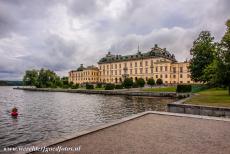
Royal Domain of Drottningholm: Drottningholm Palace is the private home of the Royal Family of Sweden. The 17th century Drottningholm Palace stands on Lovön Island in Lake Mälaren, situated just west of Stockholm in Sweden. The name Drottningholm means 'Queen's Island'. The Royal Domain of Drottningholm gained the status as a UNESCO World Heritage in 1991.
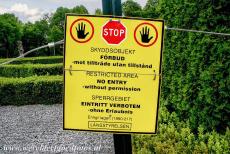
Royal Domain Drottningholm: Forbidden parts of the garden. The gardens of Drottningholm are inspired by several styles, such as the French garden style and the English landscape style. The oldest parts of the garden were created at the end of the 1600s. The most impressive parts of the palace and most areas of the gardens are open to visitors almost all year round.
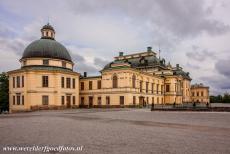
Royal Domain of Drottningholm: The Royal Chapel of Drottningholm was inaugurated in 1746 and has been in continuous use ever since. The Royal Chapel of Drottningholm has witnessed many royal christenings and other royal events. The chapel also serves as a parish church. A high mass is held on the last Sunday of every month.
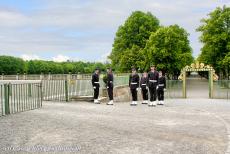
Royal Domain of Drottningholm: The Royal Guards at Drottningholm prepare for the changing of the guards. The changing of the Royal Guards is a hundred years old ceremony, it takes place every day at twelve o'clock. Drottningholm Palace is the primary residence of the Royal family of Sweden. The royal apartments are situated in the south wing of the palace.
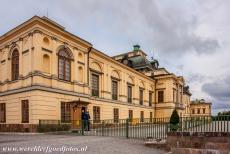
Royal Domain of Drottningholm: The Royal Guard at Drottningholm Palace. The 16th century Drottningholm was destroyed by fire in 1661, a new palace was designed, the works started in 1662. Drottningholm Palace was rebuilt as we know it today, it is a well preserved royal palace. Drottningholm was inspired by the Palace of Versailles in France.
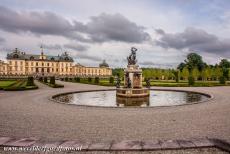
Royal Domain of Drottningholm: The Hercules Fountain was created by the Dutch sculptor Adriaen de Vries. The Hercules Fountain stands at the centre of the Drottningholm Palace Park. Museum De Vries at Drottningholm Palace houses an unique collection of sculptures by Adriaen de Vries. The Royal Domain of Drottningholm with its Palace Park is a UNESCO World Heritage.
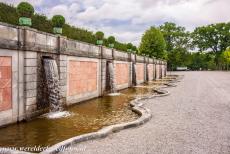
Royal Domain Drottningholm: Water cascades in the Baroque garden of Drottningholm Park. The bronze sculptures in Drottningholm Park were created by Adriaen de Vries. The sculptures were transported from Prague to Sweden in 1648. Now, these culptures have been replaced by modern bronze casts, the originals can be admired in the Museum De Vries at Drottningholm.
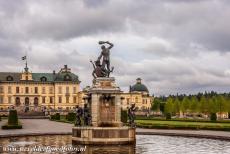
Royal Domain Drottningholm: The renowned Hercules Fountain, Drottningholm Palace in the background. The Hercules Fountain was created by the Dutch sculptor Adriaen de Vries, known as the 'Dutch Michelangelo', his works are equally rare. Adriaen de Vries worked for aristocratic families in Europe and he was the court sculptor of Emperor Rudolph II in Prague.
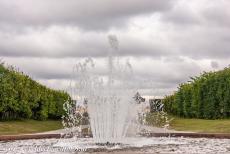
Royal Domain Drottningholm: Drottningholm is situated behind the fountain, large parts of the surrounding French Baroque gardens have been preserved. The original bronze sculptures by the Dutch artist Adriaen de Vries (1556-1626), a celebrated sculptor at the time, have now been replaced by replicas. The original sculptures are housed in Museum De Vries at Drottningholm.
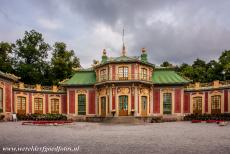
Royal Domain of Drottningholm: The Chinese Pavilion, the Kina Slott, in Park Drottningholm was a present for Queen Lovisa Ulrika on her birthday in 1753. The original wooden Chinese Pavilion was replaced in 1760 by a more permanent Chinese Pavilion, this second and current Kina Slott was completed in 1769. The Kina Slott is decorated in the Rococo style.
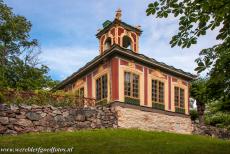
Royal Domain of Drottningholm: The Kina Slott is a small Chinese Pavilion in the palace park. The Kina Slott is an important example of the Chinoiserie in the 18th century. The Chinoiserie style is a mixture of Western and Oriental art and architecture, Chinoiserie was a popular style among the royals and aristocrats of Europe.
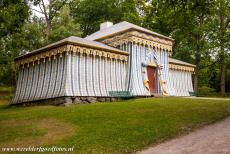
Royal Domain of Drottningholm: The Corps de Garde Building, also known as the Guards' Tent. The Corps de Garde Building was designed in the style of a Turkish tent. The tent was built in 1781-1782 for the royal guards of the Kina Slott, the Chinese Pavilion. The tent was restored in the 1990s and it regained its original colours.
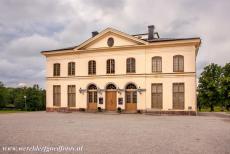
Royal Domain of Drottningholm: The Drottningholms Slottsteater is an opera house located in the garden of Drottningholm Palace. The present Drottningholm theatre was built in 1766. An earlier theatre was destroyed by a fire in 1762. The Drottningholms Slottsteater is still in use, it can accomodate 400 people.
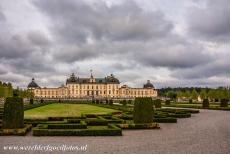
Royal Domain of Drottningholm: Drottningholm Palace is surrounded by a French Baroque garden and by an English garden. Drottningholm Palace, including the Drottningholm Theatre, the Kina Slott and the gardens, is a good example of a royal residence built in the 17th and 18th centuries. Drottningholm Palace was inscribed on the UNESCO World Heritage List in 1991.
